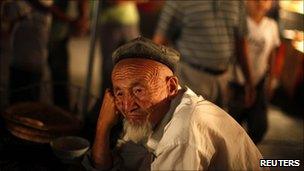Death on the Silk Route: Violence in Xinjiang
- Published

There is a heavy security presence on the streets of Kashgar, the scene of recent violence
Kashgar and Hotan, historic centres of Uighur and Islamic culture in the south of China's Xinjiang Uighur Autonomous Region, have been the scene of recent bloodshed.
The reasons behind the violence in these two cities, which lie 520km (323 miles) apart on the southern fringes of the Taklamakan Desert, are confused and disputed but some of the essential facts are clear.
On 18 July a group of Uighurs armed with knives and explosive devices attacked a police station in Hotan and took hostages. During a rescue operation, at least one police officer, two of the hostages and some of the attackers were killed.
Among the grievances of these Uighurs were: the detention of many young male family members without trial after the anniversary of the July 2009 Urumqi riots; attempts to ban women from wearing black headscarves and robes; and the confiscation of their farmland for redevelopment. Some sources have reported that 20 people died in this incident.
In Kashgar the violence broke out on 30 July, just before the Ramadan fast. There were two explosions and a hijacked car was driven into pedestrians on a crowded street where Han Chinese workers regularly gather at food stalls: six or seven people died and almost 30 were injured.
On the afternoon of 31 July a restaurant in Kashgar was set on fire and the owner and a waiter were killed. Although no specific grievances have been mentioned in connection with these attacks, the citizens of Kashgar have been outraged at the demolition of the traditional Uighur houses in the centre of the old city.
The official reason for the demolitions was that the houses were unhygienic and potentially dangerous in an earthquakes, but Uighurs believe that it is simply a stratagem to break up their communities and reduce their influence in the city.
People continue to live and work among the ruins: heavily armed police patrol regularly, and very visibly, on foot and in armoured vehicles. The atmosphere is tense.
'Strike hard campaign'
Behind the current conflict lies a long struggle for self-determination by the Uighur people. Although Xinjiang is in the far north-west of China, it is also culturally part of Central Asia and the Uighurs, who are the largest single ethnic group in Xinjiang, are Turkic-speaking Muslims.
When the Soviet Union collapsed in 1991 and the Muslim Central Asian states gained their independence, the dormant Eastern Turkestan independence movement in Xinjiang was stirred into a revival.

Many Uighurs complain that mainly the Han Chinese are taking their jobs
During China's economic boom, Xinjiang has received considerable state investment in industrial and energy projects that have in theory benefited the whole region. However, there has also been large-scale migration of mainly Han Chinese workers from the east: many Uighurs complain that the Han are taking their jobs.
The shocking but not unexpected outbreak of violence in July was not the first in Xinjiang, and it is unlikely to be the last.
In July 2009, riots in Urumqi, the administrative capital of Xinjiang, cost the lives of at least 200 people and drew the attention of the world's media to an ethnic and political conflict that has been neglected for decades.
In 1995 there were serious disturbances in the north-western city of Ghulja, which had been the headquarters of an independent Eastern Turkestan Republic in the 1940s. A rigorous crackdown by the local government and military developed into a permanent "Strike Hard" campaign, and this provoked a further outbreak of demonstrations in February 1997 which were vigorously suppressed.
Thousands of Uighurs were detained; some were convicted and imprisoned; others charged with separatist activity were executed. Religious activities, which have become less restricted in the rest of China, were curtailed in Xinjiang; children under the age of 18 and Communist Party and government officials were forbidden even to enter a mosque for prayers.
The real culprits
The official response has been to characterise these outbreaks of violence simply as "terrorist" acts and to blame outside forces, including Uighur groups based in the United States and in Europe. Overseas groups actively promote the idea of an independent Eastern Turkestan, but there is no evidence linking them directly with violence inside Xinjiang.
More recently Beijing has pointed to international terrorist organisations, including al-Qaeda, as possible culprits: but again no concrete evidence has been produced. In 2003 the death was announced of Hasan Mesum, who had been shot in South Waziristan on Pakistan's border with Afghanistan and he was identified as the leader of the Eastern Turkestan Islamic Movement (ETIM).
In the wake of the recent attacks in Hotan and Kashgar, the Chinese authorities have revived concerns about terrorists trained by ETIM in Pakistan although most specialists do not even believe that ETIM exists as a real organisation.
The dire situation of the Uighurs in Xinjiang is at the root of the conflict. Only when the real culprits - poverty, marginalisation and discrimination - are defeated can the conflict be satisfactorily resolved.
Michael Dillon is the author of Xinjiang: China's Muslim Far Northwest and the forthcoming Xinjiang and the Expansion of Chinese Communist Power: Kashghar in the Twentieth Century